When I was a boy living in France, my favorite book was the “Song of Roland”. I thrilled to the stirring battles and the chivalry, bridled at the betrayals of Ganelon, and wept at the death of Oliver and Roland. I loved Count Roland, Lord of the Breton March. I had no idea what the Breton March was but that didn’t matter. Later in life, I investigated and discovered that the March was a border zone created to defend a kingdom against an enemy. Roland, therefore, was the lord of the area that kept the Bretons from France, a most important post for the security of the Carolingian kingdom.
Later I found that my own ancestors accompanied lords of another march, in this particular case, the Welsh march. Bernard de Neufmarché (also known as Bernard of Newmarche) was granted territories in Brecon and my ancestor, Reginald de Sancto Alberico, or Reginald Awbray, was granted estates in Abercynrig. This march protected the borderlands of Norman England from the Welsh.
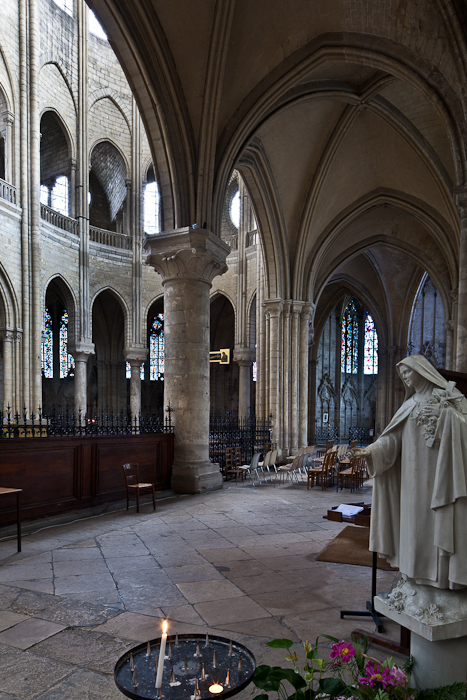
There was a march in France that protected the French crown from the Normans, the Norman march. The Norse nobleman Rollo carried on extensive raids throughout France and besieged Paris and Chartres. He was defeated in the Battle of Chartres and signed the Treaty of Saint-Clair-sur-Epte in 911. The treaty established the Ducy of Normandy. The great grandson of Rollo was William the Conqueror and he continued to dispute the Norman March with the King of England. In 1087 he besieged and pillaged the town of Mantes, a short 15 miles south of Saint-Clair-sur-Epte, and burned the cathedral to the ground. During this campaign, he suffered a fatal injury in a fall from his horse and died in Rouen.
In the following century, the Capetian crown paid to rebuild the church at Mantes; that church is the Collégiale Notre-Dame de Mantes-la-Jolie. Although it is not a cathedral, it is built on a scale fit for a great bishop. And just as important, it has never been reconstructed and is an authentic contemporary of that other early Gothic masterpiece, Notre Dame de Paris thirty-five miles to the east. Like the Paris cathedral, we can see the two short towers connected by an open colonnade. Because of the strong similarities between the two buildings, some scholars believe that they were built by the same architect.
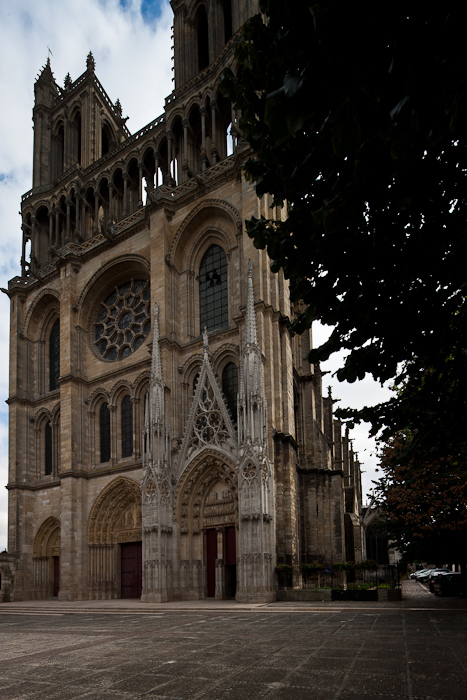
The Collégiale Notre-Dame is a beautiful early Gothic construction and features some of the first flying buttresses ever attempted. And like the original Notre Dame de Paris, the church has no transepts.
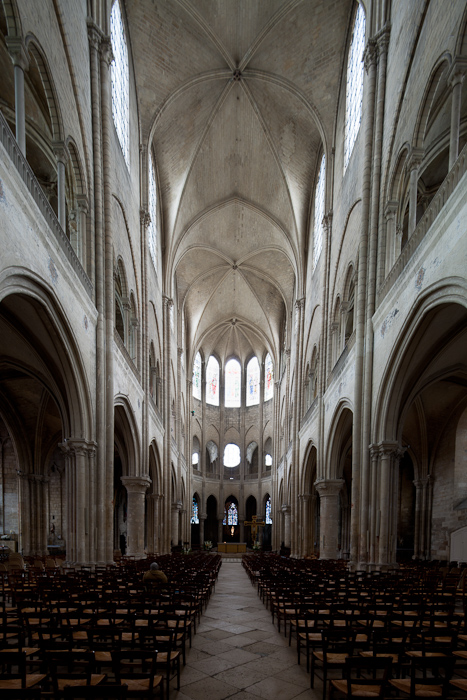
The narrow nave features a wonderful tribune with three arches in each bay that opens onto the inner church. The nave pillars alternate between compound piers and columns.
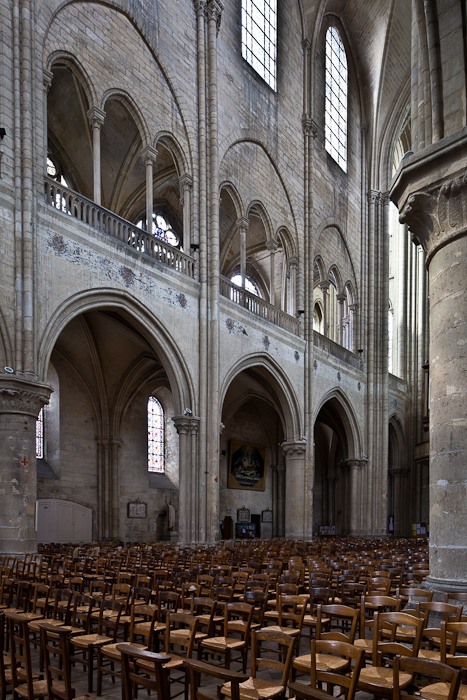
The nave is topped by a typical early-Gothic sexpartite vault. Each section of this vault spans two nave bays with an rib from the two center piers intersecting the diagonal ribs.
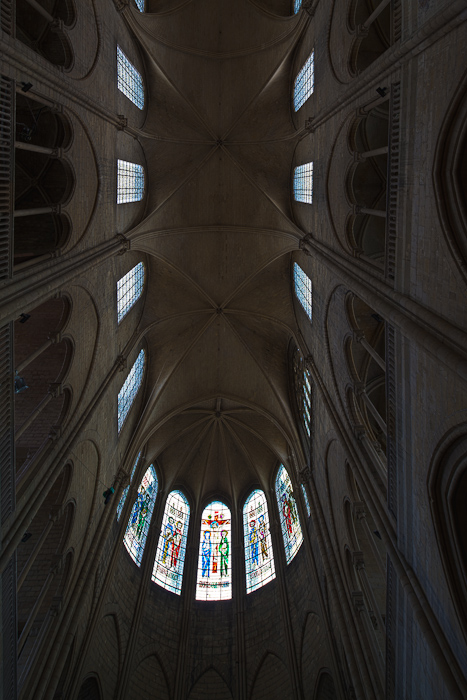
Because the tribunes are so wide, the side aisles are also quite wide in comparision to the width of the nave. In this shot we can see the compound piers that support the springing to all the different vaults and arches.
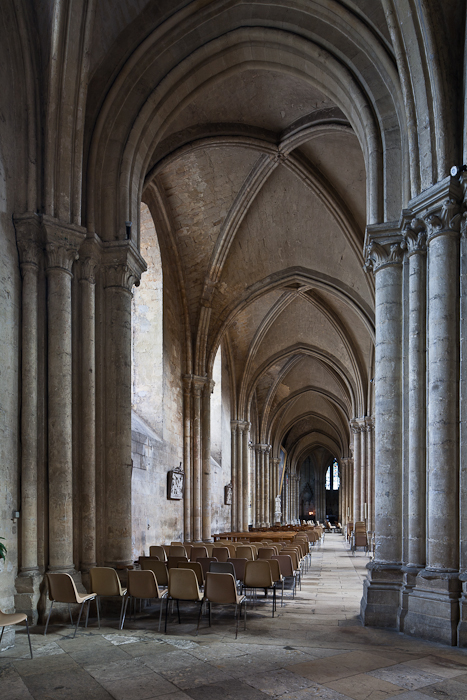
There is a wonderfully distinctive feature in the gallery vaulting. The exterior walls at this level are massively thick, so a very creative solution was found to let light into the church. It is a bit difficult to see in the following photograph, but on the left side we can see that each bay features a pointed transverse barrel vault. This leaves a space at the end of the vault where the builders could place a large round window, or oculus, in the outside wall, which can be seen in the bays at the right. This vaulting is unique in France.
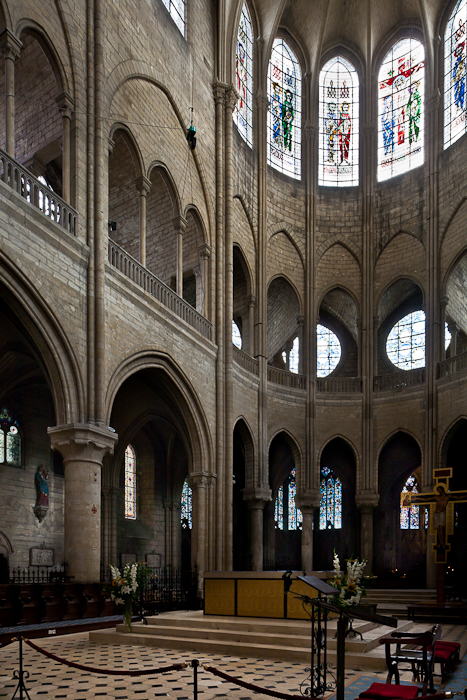
Eventually eight of the arcade bays were remodeled with quadripartite vaults and the oculi were replaced with pointed-arch windows, but the original construction makes it clear that much experimentation was going on in the development of early Gothic architecture. We are lucky that this wonderful church has survived so well in the past, especially since much of Mantes-la-Jolie was flattened in World War II preparatory to Patton crossing the Seine at this point. Perhaps the gods of war had decided that William’s destruction was enough for awhile and the Collégiale Notre-Dame would stand, hopefully for another eight hundred years.
Location: 48°59’25.45″N 1°43’12.52″E

I think many, if not most, followers of this site are touched by the beauty of the photography or the descriptions of the architectural features. While I enjoy both of those aspects of the site, what I most enjoy is the way you carefully describe the history associated with the churches. That’s the wonder of the site for me; lots of us can take beautiful photographs of the churches (although few can compare with yours), and only a relatively small amount of study is required to understand the architecture, but unearthing the history – that’s a real challenge and you do it so well. Thank you.
Thanks, Jay. I have always been a history buff (my father describes one of his proudest moments that, after we had moved to France when I was 12, I came to the dinner table breathless with anticipation. I had just discovered that the Battle of Poitiers (Charles Martel against the Saracens) was fought near where we lived.)
But for the purposes of Via Lucis, there is so much interesting history surrounding these churches and cathedrals. We have hundreds of books on the subject and I have read them all. Sometimes the problem is cutting the post down to something reasonable for a blog!
I appreciate your kind words, Jay, and your encouragement.
Your observation that Mantes may have shared an architect with Notre Dame in Paris has a lot of merit. I was initially thinking Laon (the facades are dead-set replicas of each other) but the Mantes elevation cuts out the extra triforium. The transverse barrel vaulting/gallery level occuli are something I have never seen before, and considering how early this church was built, represent a major innovation in illuminating the interior space. I really look forward to learning something new everytime you post!
Nathan, you probably are aware that the transverse barrel vaults were used in the naves at Tournus and Mont Saint Vincent in the Saône-et-Loire. The only other place that uses them in the arcades was at Canterbury, designed by William of Sens.
Glad that you learn something from these posts – I do myself! Also, Laon is the same basic time period as Mantes-Notre Dame de Paris, so it is not surprising that they have many features in common.
hi, i loved the photos but, better yet, i loved yr personal touch. yr history aka genealogy–
-i am sorry i seem to have lost touch with my w.my grammar skills.
Thanks, K, once again for your kind words.
I love the way you set your beautiful photographs of spectacular architecture in their historical context. I have a personal interest in the Marches of Wales – having been born in Hereford I discovered quite recently that it was the Welsh Marcher Lords who occupied much of Ireland in the twelfth and thirteenth centuries. I would not be surprised if some of your ancestors were among them!
Frank, thanks for the kind words. I had no idea that the Welsh Marcher lords occupied Ireland. Looks like I’ll have to spend some more time in your Hereford and Ireland history site!
Beautiful!
ref your comment that the church ‘has never been reconstructed’, above the shot of teh main facade; there is a museum on the south side of the facade in which there is an interesting 19th C. watercolour drawing of the Collegiale before the addition of the flambouyant south doorway and some other facade remodelling.